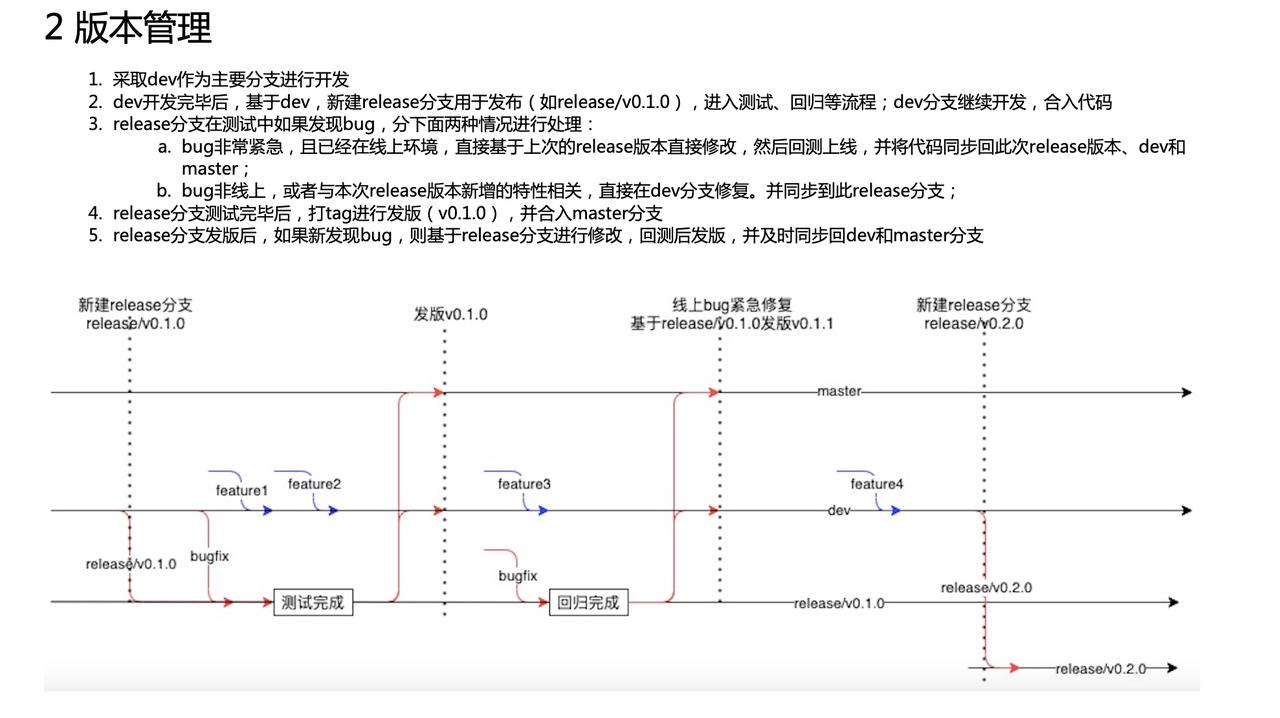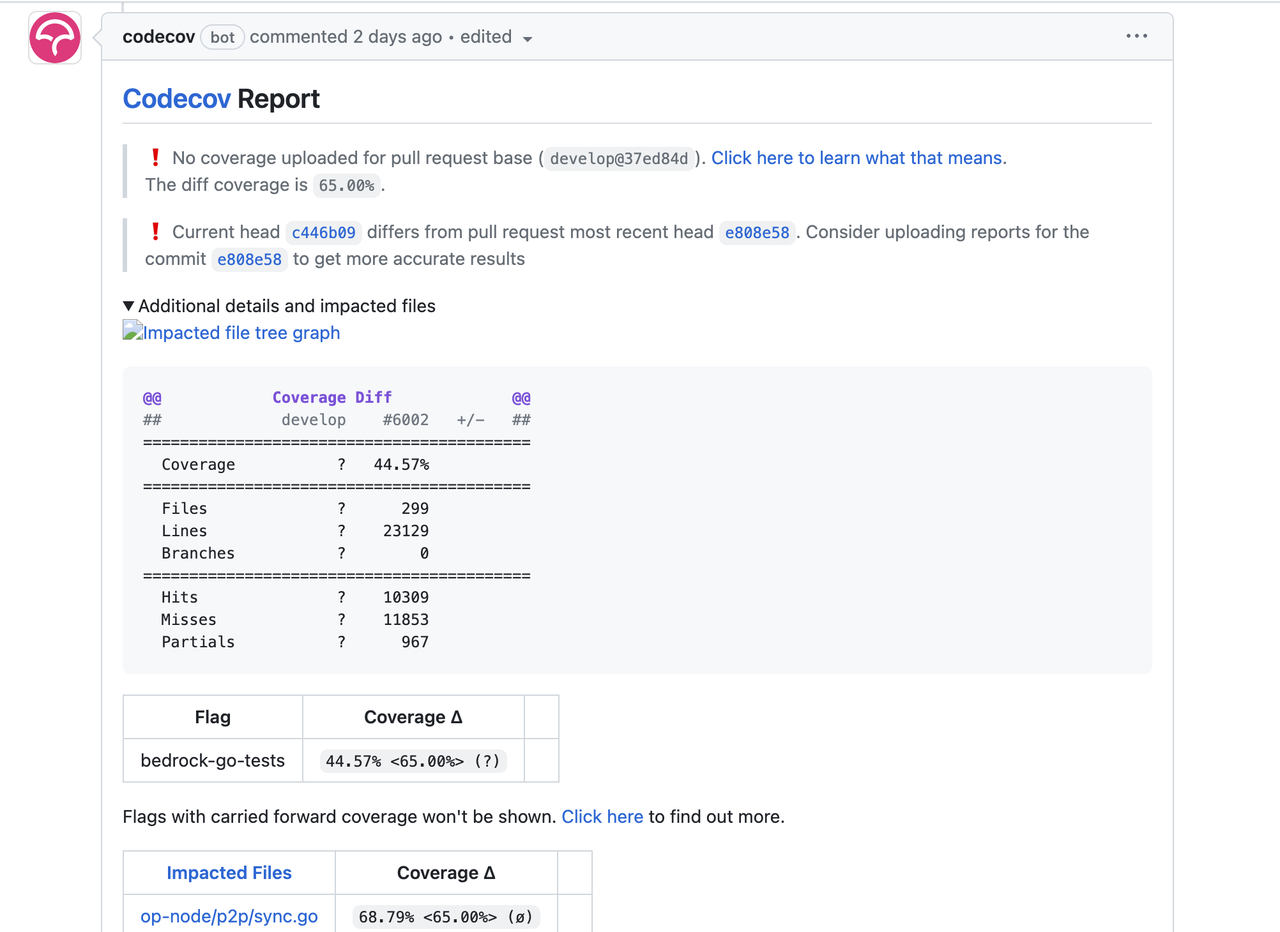一.总的 Release
Gitflow 定义参考
具体定义: https://www.atlassian.com/git/tutorials/comparing-workflows/gitflow-workflow

二. SemVer定义
https://semver.org/lang/zh-CN/
1.项目中使用规范
1.1.分支命名规范
单词使用单数,完全小写,不要加 s
- feature/short-description
- release/v0.1.1
- bugfix/short-description
- hotfix/short-description
short-description 表示自己起的名字
1.2.squash merge使用
- 私人分支--> 公共分支,用 squash merge ,自己的杂七杂八的的提交可以压缩成 1 个 commit,
- 公共分支 --> 公共分支用 merge pull request,要保留其他人的提交历史
1.3.Release 分支
- 从 develop 切出 release/v0.4.1,
- 测试完成,合到 main,打
tag v0.4.1-alpha.1,v0.4.1-beta.1,v0.4.1-rc.1具体适合哪个待定 - devops 基于 tag 发版 testnet
1.4. Hotfix 分支
例如要修 release/v0.4.1
- 基于前面的 release,修复
- 测试完成,合并到 main,打 tag v0.4.1-alpha.2 之类的
- devops 基于 tag 发版
- Main 合回 develop
- 直到没有需要fix的东西,打 tag v0.4.1 最终版
- 如果又发现了问题,从 develop 切 release/v0.4.2 来修吧,等于是把 fix 放到下个小版本
2. 需要外部配合的 break change
升中间版本号,比如 v0.5.0,第一位暂时保持 0 不变
3.DevOps 部署只用 tag
分支保护规则
- main develop 不允许直接 push,不允许 force push
- release/* 不允许直接push,允许指定的人 force push (用于极少情况下回滚代码用)
- 重要的 feature 分支不允许直接 push:
二. 代码风格参考规范
1.Go imports
package genesis
import (
"bytes"
"encoding/json"
"math/big"
"os"
"testing"
"time"
"github.com/ethereum/go-ethereum/accounts/abi/bind"
"github.com/ethereum/go-ethereum/accounts/abi/bind/backends"
"github.com/ethereum/go-ethereum/common"
"github.com/ethereum/go-ethereum/common/hexutil"
"github.com/ethereum/go-ethereum/crypto"
"github.com/ethereum/go-ethereum/params"
"github.com/ethereum-optimism/optimism/op-bindings/bindings"
"github.com/ethereum-optimism/optimism/op-bindings/predeploys"
"github.com/ethereum-optimism/optimism/op-chain-ops/deployer"
"github.com/stretchr/testify/require"
)
第一部分,golang原生的包 第二部分,以太坊里面的包 第三部分,本地包 第四部分,其他第三方的包
参考这个文档,配置一下goland,然后通过go format imports就能自动实现 https://medium.com/codex/better-format-your-go-imports-ce22cd648b34 Comment
// BuildL1DeveloperGenesis will create a L1 genesis block after creating
// all of the state required for an Optimism network to function.
func BuildL1DeveloperGenesis(config *DeployConfig) (*core.Genesis, error) {
}
注释以函数名开头,主要描述此函数的功能,如果参数比较多,或者命名不能直观的表示参数代表的意思,在注释里面也要加上说明
2.Tests
2.1.Unit tests
https://github.com/ethereum-optimism/optimism/blob/e33d000561af65dbf438f5b8acfcc50c729a775e/op-chain-ops/genesis/layer_one.go#LL65C3-L65C3
// BuildL1DeveloperGenesis will create a L1 genesis block after creating
// all of the state required for an Optimism network to function.
func BuildL1DeveloperGenesis(config *DeployConfig) (*core.Genesis, error) {
}
https://github.com/ethereum-optimism/optimism/blob/e33d000561af65dbf438f5b8acfcc50c729a775e/op-chain-ops/genesis/layer_one_test.go#L24
func TestBuildL1DeveloperGenesis(t *testing.T) {
b, err := os.ReadFile("testdata/test-deploy-config-full.json")
require.NoError(t, err)
dec := json.NewDecoder(bytes.NewReader(b))
config := new(DeployConfig)
2.2.命名
以Test+测试对象函数名: TestBuildL1DeveloperGenesis = Test + BuildL1DeveloperGenesis
适用场景 - 对功能比较单一,且相对独立的函数,可以通过单元测试验证功能。并且后期维护的人员也可以通过单元测试了解函数功能。
3.Coverage
- Code reviewer需要在本地运行单元测试,并评估单元测试的覆盖率。
- PR里面可以自动生成 unittestc运行的报告

4.Issue
4.1.Bug
- 标题里面最好能简要表示是什么问题,如果能确定是那个组件出问题,那么以这个组件开头,比如sequencer里面问题那么标题可以为
Sequencer: Panic issue
- 如果这个 bug 且需要他人修复,那么需要写明 bug 的现象,发现 bug 的运行环境,binary 版本号,以及重现步骤
- 给改 issue 打上标签,比如 bug,improvement,feature
4,2. Improvement & Feature
- 标题里面简要写明要做什么样Improvement & feature
- 在description里面写明为什么需要这个Improvement & feature
- 如果是一个全新的feature,那么应该在issue里面把spec讨论清楚,并且这个spec要被包含在相应的PR中
- 给改issue打上标签,比如bug,improvement,feature
5. PR
-
PR 要有对应的 Issue,如果 Issue 里面对要解决的问题已经解决方案进行了详细的说明和论证,那么 PR 里面的 descrption 就是简单的写成: Close [issue 链接]。对于develop到main合并的PR,在PR的description里面要列出所有issue,并加上其他release方面的描述。
-
创建和修改 PR 自动触发运行 unitest 和 e2e test(这个需要配置 github,我接下来会着手这块),有运行失败的情况,不允许 merge。必须着手去解决测试的问题
-
PR 的 viewer 人员一定要详细看代码,不能走过场。
-
还没开发完的 PR以 WIP(work in progress) 开头,可以 review 的 PR 以 R4R(Ready for review)开头
